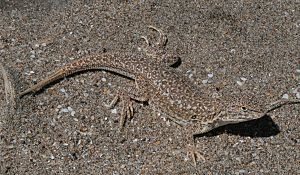Many-spotted tree iguana facts for kids
Quick facts for kids Many-spotted tree iguana |
|
|---|---|
 |
|
| Conservation status | |
| Scientific classification | |
| Genus: |
Liolaemus
|
| Species: |
multimaculatus
|
The many-spotted tree iguana (scientific name: Liolaemus multimaculatus) is a special type of lizard. It belongs to the Iguanidae family, which includes many different kinds of iguanas and lizards. This lizard is found only in Argentina, a country in South America. It's known for its unique spotted patterns.
Contents
Liolaemus multimaculatus: The Many-Spotted Tree Iguana
The many-spotted tree iguana is a fascinating reptile. It lives in specific environments and has interesting ways of surviving. Scientists study these lizards to learn more about their lives and how to protect them.
What Does It Look Like?
The Liolaemus multimaculatus gets its name from the many spots on its body. These spots help it blend in with its surroundings. Like other lizards, it has scales covering its skin. Its body shape helps it move quickly and climb.
Appearance and Size
These lizards are usually small to medium-sized. Their colors can vary, but they often have patterns of brown, gray, or tan with darker spots. This coloring helps them hide from predators and sneak up on prey. Their strong legs and sharp claws are perfect for climbing trees and rocks.
Where Does It Live?
The many-spotted tree iguana lives in specific parts of Argentina. It prefers certain types of habitats where it can find food and shelter.
Habitat and Climate
This lizard typically lives in sandy areas, like dunes, or in places with scattered trees and shrubs. These environments provide good places to bask in the sun and hide. The climate in these regions can be quite warm and dry, which is perfect for reptiles. They often dig burrows or find shelter under rocks to escape the heat or cold.
What Does It Eat?
Like most lizards, the many-spotted tree iguana is an insectivore. This means its diet mainly consists of insects.
Diet and Hunting
It hunts for various insects and small invertebrates. These can include beetles, spiders, and ants. The lizard uses its sharp eyesight and quick movements to catch its prey. It often waits patiently for an insect to pass by before striking quickly.
How Does It Live?
The many-spotted tree iguana has several behaviors that help it survive in its environment.
Behavior and Adaptations
These lizards are usually active during the day, especially when the sun is out. They love to bask in sunny spots to warm up their bodies. This is important because lizards are cold-blooded, meaning their body temperature depends on their surroundings. When it gets too hot, they find shade or go into their burrows. They are also very good at camouflaging themselves, using their spotted skin to blend into the sand or tree bark.
Reproduction and Life Cycle
Lizards like the many-spotted tree iguana reproduce by laying eggs. The female lizard will find a safe place to lay her eggs, often burying them in the sand or under rocks. After a period, the baby lizards hatch from the eggs. They are usually small versions of the adults and must learn to hunt and survive on their own. The life cycle involves growing from a hatchling to a juvenile, and then to a mature adult that can reproduce.
Why Is It Important?
Every species plays a role in its ecosystem. The many-spotted tree iguana is an important part of the food web in its habitat.
Conservation Status
Unfortunately, the many-spotted tree iguana is listed as an Endangered species. This means its population is decreasing, and it faces a high risk of extinction. The main threats to this lizard often include habitat loss, which happens when its natural home is destroyed or changed by human activities. Protecting their habitat is very important to help these lizards survive. Conservation efforts aim to preserve their natural environments and ensure their future.
See also
 In Spanish: Lagartija de las dunas para niños
In Spanish: Lagartija de las dunas para niños


